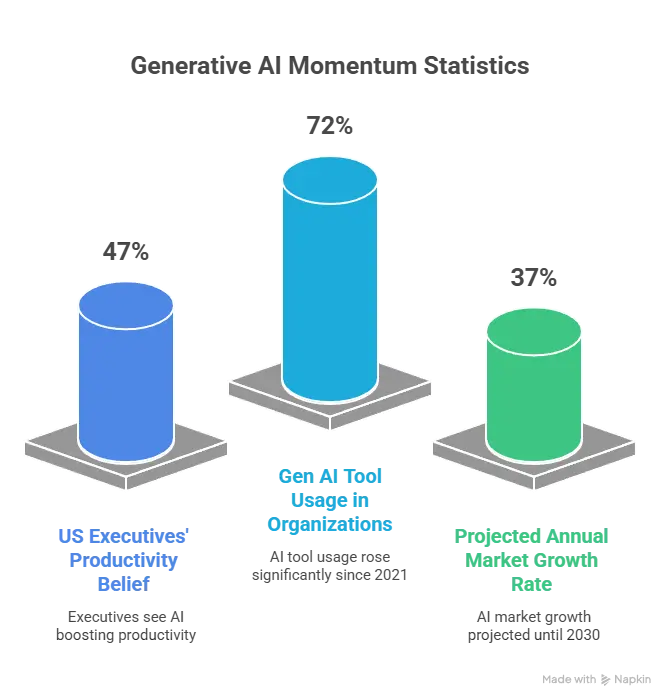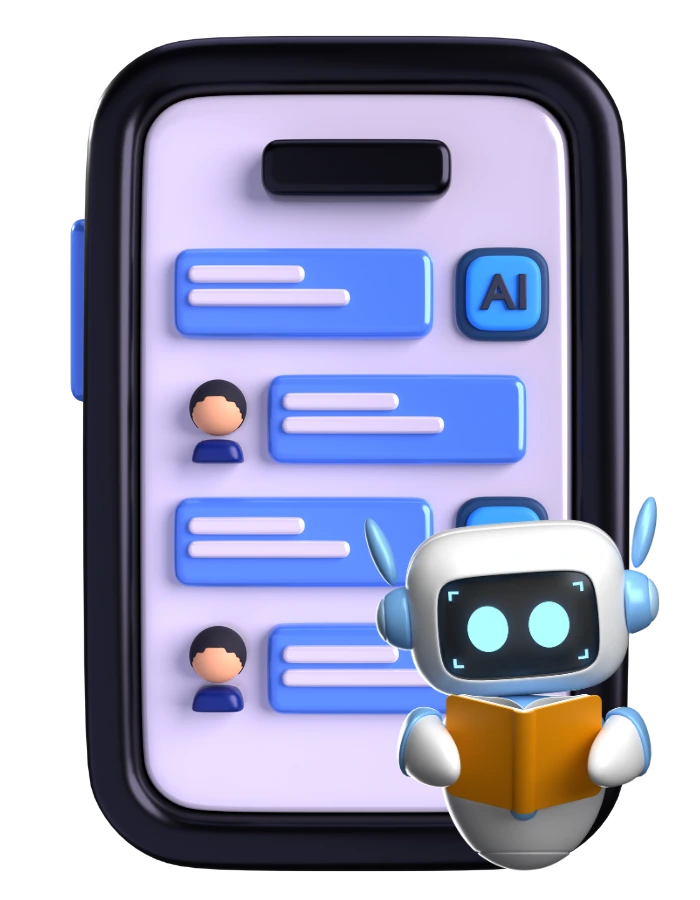In my twenty-plus years guiding operations and strategy within large-scale engineering and technology ventures, I’ve observed a recurring theme: when a compelling new capability emerges, the real test is how it gets embedded into industry workflows. With the rise of generative AI (Gen AI) — systems that can create text, images, designs, code, and more based on existing data and models — we’re now seeing major industrial systems transform. In this blog I describe the top generative AI use cases reshaping industries today, from healthcare to manufacturing, finance to retail, and outline practical considerations, success metrics, and technical insight into how this transformation plays out.
What is Generative AI and Why Does It Matter?
At the outset, let me define what I mean by generative AI: it’s a subset of artificial intelligence that uses models (often large language models, image-generation models, code-generation engines, etc) to produce new content or outputs rather than simply classify or predict. In operational terms, it means machines do more than observe—they create.
From an industrial strategy standpoint, this matters because creation has historically been human-centric: designing products, writing content, engineering solutions, generating code, designing processes. Now those capabilities are being augmented or taken over by the machine-side of the value chain.

Statistically, the momentum is already high. For example:
-
Nearly 47 % of US executives believe generative AI will boost productivity.
-
Use of Gen AI tools in organisations rose from 56 % in 2021 to 72 % in early 2024.
-
McKinsey and others estimate Gen AI features could add up to US$4.4 trillion in annual value to the global economy.
-
The Gen AI market growth rate is projected at ~37 % annually toward 2030.
These numbers tell me: this isn’t fringe innovation. It’s moving fast, and industries must adapt or risk falling behind.

Top Use Cases by Industry
Below I summarise some of the most impactful use-cases by sector, along with technical/practical commentary.
1. Healthcare & Life Sciences
In healthcare, generative AI is changing how we diagnose, personalise, research and treat.
-
Use case: Image-analysis and patient intake support — models analyse scans (radiology, pathology) and generate draft interpretations or highlight anomalies.
-
Use case: Drug discovery and molecule generation — companies use Gen AI to generate new candidate molecules, accelerate timelines (e.g., one firm generated new drug candidates in ~46 days).
-
Practical benefit: Clinicians are freed from repetitive data-capture, workflows can shift toward higher-value tasks (treatment planning, patient interaction).
-
Technical note: Key enablers are large datasets (medical images, historical treatments), strong model-training infrastructure, rigorous validation (accuracy, bias, safety) and domain-specific fine-tuning.
2. Manufacturing & Industrial Operations
From heavy equipment to discrete manufacturing, Gen AI is being applied in design, maintenance, supply-chain, and quality control.
-
Use case: Generative design for components – e.g., automotive or aerospace firms use Gen AI to propose structural designs that meet strength, weight, cost constraints.
-
Use case: Predictive maintenance driven by generative modelling – sensors feed into models that generate forecast maintenance schedules and defect detections.
-
Operational impact: Through generative workflows, we reduce design cycles, shorten time-to-market, reduce unplanned downtime, improve quality.
-
Technical insight: Integration is non-trivial—requires sensor networks, high-quality data, feedback loops (human review), and domain-knowledge embedding (materials, process physics).
3. Financial Services / Banking
In banking, insurance and capital markets, Gen AI is being applied to customer service, risk modelling, personalization and compliance.
-
Use case: AI agents in contact centres that auto-summarise calls, generate responses, and assist human agents.
-
Use case: Personalized product-recommendation generation and market-scenario modelling – firms use generative algorithms to propose tailored financial products or simulate outcomes.
-
Business result: Improved customer experience, faster time-to-service, lower manual cost.
-
Technical note: Financial systems have heavy regulatory/compliance requirements; thus model governance, auditability, transparency, explainability become critical in adoption.
4. Retail, Marketing & Customer Experience
In consumer-facing industries, generative AI is revolutionising content, product descriptions, marketing campaigns, visual assets and personalisation.
-
Use case: Auto-generation of product descriptions, image variants, marketing copy, campaign assets. Example: e-commerce platforms using Gen AI to generate unique item descriptions and ad creatives.
-
Use case: Chatbots and conversational agents that generate responses, guide purchases, personalise interactions.
-
Metrics: Marketers report time-savings of ~3 hours per piece of content when using Gen AI tools.
-
Technical landscape: Multimodal models (text + image + video) are increasingly relevant; prompt engineering, bias monitoring and brand-consistency guardrails become vital.

5. Oil, Gas & Energy (including Natural Resources)
Within energy, upstream/downstream and logistic operations, Gen AI is starting to provide value.
-
Use case: In subsurface geology and seismic data – AI models generate possible subsurface scenarios, accelerating exploration decision-making.
-
Use case: Process optimisation in refineries, predicting malfunctions, modelling fluid flows, planning logistics and transportation routes.
-
Practical effect: Reduced non-productive time, improved safety, faster decision cycles, lower downtime.
-
Technical remark: These environments demand high reliability, real‐time systems integration, rigorous HSE validation. For an engineer with decades of experience, I note that the human oversight remains essential – these models augment rather than replace domain experts.
Cross-Industry Practical Themes
From my perspective, across sectors the following themes stand out in successful Gen AI deployments:
-
Task decomposition & pilot selection: Starting with targeted workflows (e.g., customer-service summarisation, design variant generation) rather than trying full-scale transformation all at once.
-
Data readiness & quality: High-quality, well-labelled, domain-relevant data sets remain a critical bottleneck.
-
Governance, ethics & risk management: Especially in regulated industries (healthcare, finance, energy) ensuring explainability, audit trails, model monitoring, bias/time-drift control.
-
Human-in-the-loop (HITL) design: Generative outputs must be reviewed, refined and controlled; many organisations adopt workflows where humans check before deployment.
-
Scalability & ROI orientation: Many enterprises found that only a minority of use cases produce the majority of value. One major firm found 10–15 % of Gen AI use cases delivered ~80 % of the value.
-
Integration with existing systems: Generative models must plug into existing enterprise architecture, workflows, process automation, not operate as siloed tools.
Why This Matters for Strategy
For companies providing digital, cloud or services offerings (as you are), the implications are significant:
-
You can shift from simply being a service vendor to being a value-creation partner by embedding Gen AI capabilities into your offering (e.g., accelerated design, assisted coding, auto-content generation).
-
Early movers gain competitive advantage: while many firms are still experimenting, the gap between adopters and laggards widens.
-
For clients in energy, manufacturing, financial services, demonstrating credible Gen AI use-cases becomes a differentiator.
-
Risk management is elevated: maturity in Gen AI governance becomes a selling point (especially in regulated verticals).
-
Operational efficiency improvement is real: one survey suggested the Indian IT industry could see productivity boosts of 43-45 % via Gen AI.
From my experience, when you plan a Gen AI roadmap, you need three things aligned: clear business case (which task is being improved), technical/data feasibility (do you have the data/infrastructure), and adoption/governance (can your organisation integrate this responsibly).
Frequently Asked Questions
Here are five of the most common questions I encounter—and how I answer them in practical terms.
1. What are the most promising generative AI use cases across industries?
We see four high-impact classes: design/engineering generation (manufacturing, automotive), content generation (retail/marketing), conversational/agent automation (customer-service, banking), and model-driven simulation/prediction (healthcare, energy). Because Gen AI bridges creative and analytic tasks, many industries benefit.
2. Will generative AI replace human jobs?
My take: It’s more augmentation than replacement in the near-to-mid term. Generative AI handles repetitive or data-intensive tasks (drafting, early design, summarisation), letting humans focus on higher-value work (strategy, judgment, domain expertise). However, some roles will shift markedly and reskilling is prudent.
3. How should organisations start with generative AI?
Start with pilot projects: pick a high-visibility workflow with measurable metrics (e.g., reduce time to draft customer-response by X %). Ensure you have clean data, governance in place, and plan for scalability. Break down tasks, measure benefit, and scale from successful pilots.
4. What are the main risks or challenges in adopting generative AI?
Key concerns: model bias or unsafe outputs, data privacy/compliance (especially in healthcare/finance), integrating outputs into enterprise systems, lack of human review leading to quality issues, and organisational change/resistance. One survey found that 69 % of AI projects don’t live-into-operational use.
5. What metrics should we track to measure Gen AI success?
Useful metrics: productivity gain (% time saved), quality improvement (error reduction, defect rate), cost savings (manual-task cost reduction), adoption rate (users leveraging the tool), and time-to-value (how fast your deployment moves from pilot to production). Also monitor model performance drift over time.
Resource Center
These aren’t just blogs – they’re bite-sized strategies for navigating a fast-moving business world. So pour yourself a cup, settle in, and discover insights that could shape your next big move.
How Are Generative AI Use Cases Transforming Industries Today?
In my twenty-plus years guiding operations and strategy within large-scale engineering and technology ventures, I’ve observed a recurring theme: when a compelling new capability emerges, the real test is [...]
How Does Generative AI Enhance Customer Support with Chatbots?
In my two decades of experience in marketing and customer experience, I’ve observed a significant transformation in how organisations manage customer support—and the rise of generative-AI-driven chatbots is central [...]
Is Generative AI Revolutionizing Real Estate Through Virtual Tours and Smart Listings?
In recent years, the real estate sector has undergone a transformative shift driven by technology. One of the most exciting innovations in this space is Generative AI, which has [...]

